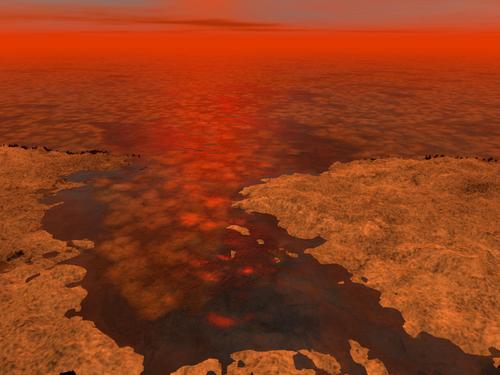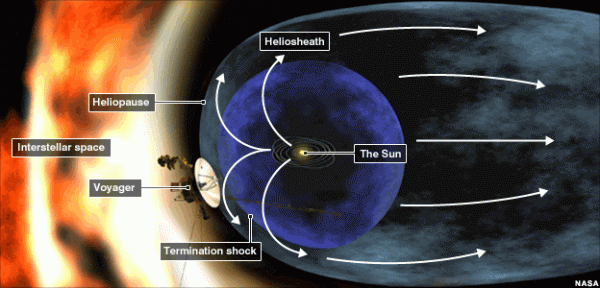
What a year for space exploration! With 2013 coming to a close I thought I would look back on some of the biggest news in space that I’ve featured here on Lights in the Dark. Rather than a “top ten” list, as is common with these year-end reviews, I’m going to do more of a month-by-month (hence the 12) to help recollect some of the amazing stories and sights that 2013 has brought us. And with some of the big headliners we’ve seen this year it’s easy to lose sight of the smaller (but no less fascinating) discoveries — so I’ll be sure to include some of those too. After all, when it comes to learning about the Universe there’s no “little” news!
Ready? Let’s go!
1. Floes of Frozen Methane on Titan’s Lakes?

(JANUARY) A model developed by scientists at Cornell University suggests that Titan’s hydrocarbon lakes may have icebergs of frozen methane floating in them, perhaps even tinted reddish-brown! While this has yet to be observed directly, the possibility is there.
“One of the most intriguing questions about these lakes and seas is whether they might host an exotic form of life,” said Jonathan Lunine, a paper co-author and Cassini interdisciplinary Titan scientist at Cornell University, Ithaca, N.Y., “and the formation of floating hydrocarbon ice will provide an opportunity for interesting chemistry along the boundary between liquid and solid, a boundary that may have been important in the origin of terrestrial life.” Read the story here.
2. Asteroid Blasts Russia While the World Watches
(FEBRUARY) Early on the morning of February 15, dashboard cameras all across the Chelyabinsk region of Russia captured the streaking flash of a fireball in the dawn skies — and shortly afterwards a deafening boom and window-shattering airblast from a 59-foot-wide meteor that disintegrated violently 14 miles above the ground. It was the largest meteor event to be witnessed by humans since the 1908 Tunguska explosion, and a reminder that plenty of space rocks are out there with our name on them. (Thus the need for asteroid-hunting spacecraft like the B612 Foundation’s Sentinel mission!) Read the story here.
3. Enceladus is Spraying an Ocean into Space

(MARCH) Ever since the Cassini spacecraft discovered in 2005 that Saturn’s moon Enceladus has jets shooting ice particles from its south pole, some of which feed the hazy E ring, the little moon has been in scientists’ spotlight as a place to hunt for extraterrestrial organics — and even possibly life. In March of 2013, researchers announced that Enceladus’ geysers are very likely drawing their salty spray up from a subsurface ocean hidden below six miles of ice, supporting earlier hypotheses and making a case for further investigation in the (hopefully) near future. Read the story here.
4. Saturn’s Rings Cast Shadows of Rain

(APRIL) Dark bands in Saturn’s atmosphere are caused by ionized water molecules drawn down from the rings, according to researchers from England’s University of Leicester. The bands, which emit less infrared radiation than the surrounding areas and equator, are kept cooler by the falling water molecules. Saturn explorers: don’t forget your umbrellas! Read the story here.
5. Near-Earth Asteroid Has a Moon of Its Own

(MAY) On the afternoon of Friday, May 31, 2013, the nearly two-mile-wide asteroid 1998 QE2 passed by our planet at a distance of about 3.64 million miles… about 15 times the distance between Earth and the Moon. Although it posed no threat of impacting Earth, on the eve of its close approach NASA revealed a surprising discovery about this cosmic visitor: it has a little moon of its very own! (What would have happened if it HAD hit Earth? Read the story here.)
6. Carbon Dioxide Toboggans on Mars
(JUNE) JPL researchers’ field trip to the U.S. Southwest showed that slabs of dry ice — frozen CO2, which is plentiful on Mars — easily slide down the faces of dry sand dunes, as their sublimated gas creates a pocket of air that supports the slab. This process is thought to be the cause of the many curious channels seen on Mars from orbit that line steep slopes of craters. Read the story here.
7. Earth and Moon as Seen from Saturn and Mercury

(JULY) We often look out toward the stars and planets, but on July 19 there were two things looking back at us: the Cassini and MESSENGER spacecrafts, in orbit around Saturn and Mercury respectively, both of which captured images of the Earth and Moon from their distant locations in the Solar System. What’s more is that we knew beforehand, and so, for the first time ever, the entire world was given the chance to get ready to smile and wave while the pictures were taken. These were the first images that came back.
“It will be a day to revel in the extraordinary achievements in the exploration of our solar system that have made such an interplanetary photo session possible. And it will be a day for all of us to smile and celebrate life on the Pale Blue Dot.”
– Carolyn Porco, Cassini Imaging Team Lead
8. Voyager 1 Leaves the Solar System… Again?

(AUGUST) In or out, what’s it gonna be? That’s what my grandparents used to say when as kids we would be in and out of the house on a hot summer day, letting the screen door fall shut behind us (multiple times) as we went. And we could say this too to the venerable Voyager 1 spacecraft, 18.7 billion kilometers away at the very edges of the heliosphere, as news of its departure has been reported several times before. Now while the Solar System proper extends out far beyond that with the Kuiper Belt and Oort Cloud, the Sun’s magnetic influence ends about there and scientists measuring the most recent data returned from Voyager once again interpreted what they saw as evidence that it has in fact “broken on though to the other side.” Read my article here on Universe Today, and then check out the news from September from the team at NASA and JPL corroborating the findings. (I got one of my questions answered during the press conference too!)
9. Asteroid Gets Uncovered as a “Rock Comet”

(SEPTEMBER) In space, things often aren’t easily categorized. Such was the case with the sungrazing asteroid Phaethon which, as it turns out, isn’t an asteroid at all — it’s a comet. But wait: Phaethon isn’t the “dirty snowball” type of comet you typically hear about but rather a rock comet, spewing hot dust and rock as it approaches the Sun in the same way that other comets eject ices. Sound exotic? Read the story here.
10. Jupiter-Bound Juno Takes a Portrait of Earth

(OCTOBER) 2013 was a year for our planet to have its picture taken, twice in July by Cassini and MESSENGER and then again in October as the Juno spacecraft sailed past during its gravity-assist flyby on its way out to Jupiter. Juno came within 347 miles of our planet’s surface, passing closest over the southern Atlantic at 3:21 p.m. EDT, and it used its JunoCam instrument to take images along the way. Here’s what they looked like.
11. Saturn Makes the Front Page

(NOVEMBER) In November the final full image of Saturn, taken by Cassini in July and including Earth, Mars, Venus, and several of Saturn’s moons, was released unto the eager internet. The results — and responses — were deservedly incredible. Read the story here.
12. Look Out Enceladus — Europa’s Got Geysers Too!

(DECEMBER) What may be the biggest space news of the year (and that’s saying a lot!) is the announcement of water vapor observed erupting from Jupiter’s moon Europa. Using Hubble observations, astronomers identified what appear to be persistent plumes containing water molecules around Europa’s south pole. The thought is that as Jupiter’s extreme gravity squeezes the moon during its orbit, when it’s farther out cracks can open and spray water out from the subsurface ocean that’s long been hypothesized to lie beneath Europa’s frozen ice crust. If this is the case, we may not have to attempt landings there right away — we could just send spacecraft through the plumes to sample what lies beneath! Read the story here.
______________
So those are just a few of my favorite space news stories from 2013. Had you missed or forgotten about any of them? Were any your favorite? If not, which were? Feel free to leave a note in the comments — I really do read them all. Obviously there were many, many more notable events in 2013 (like comet ISON’s solar suicide run, China’s robotic landing on the Moon, a map made of the Moon’s water, Canadian astronaut Chris Hadfield’s many adventures aboard the ISS, Curiosity’s watery discovery, the coldest place in the Universe… I could really go on and on and on. But there’s a whole new year ahead so I’ll save some energy for 2014’s news!
As always, thanks for reading and following me and Lights in the Dark, here and on Twitter and Facebook and the other sites I contribute to. So to you, my readers, the scientists and engineers that make all of this exploration possible, the many media and PR reps who spread the information across the digital world, and the talented and dedicated writers and bloggers I am fortunate to work with, here’s to a discovery-filled and spacetastic 2014!
“It was a cherished experience. I feel I got to see the grand order of things. In the overall scheme of things, it proves that men can do anything they want to if they work hard enough at it.”
– Scott Carpenter, Mercury astronaut and second American to orbit Earth. Died Oct. 10, 2013, age 88.

Yeah Jason,
Happy New Year to You and to Lights in the Dark.
And I wish to continue to read you here on your Blog.
Best Wishes.
Jeff Barani from Vence (France)
LikeLike
Thanks for being such a loyal reader Jeff! Happy New Year! Bonne année et bonne santé!
LikeLike
Hey Jason,
Your french is very good 😉
And today it’s really time to say you :”Happy New Year” !!
Best Wishes.
Jeff Barani from Vence (France)
LikeLike